weight AUDI A5 COUPE 2013 Owners Manual
[x] Cancel search | Manufacturer: AUDI, Model Year: 2013, Model line: A5 COUPE, Model: AUDI A5 COUPE 2013Pages: 294, PDF Size: 73.84 MB
Page 61 of 294
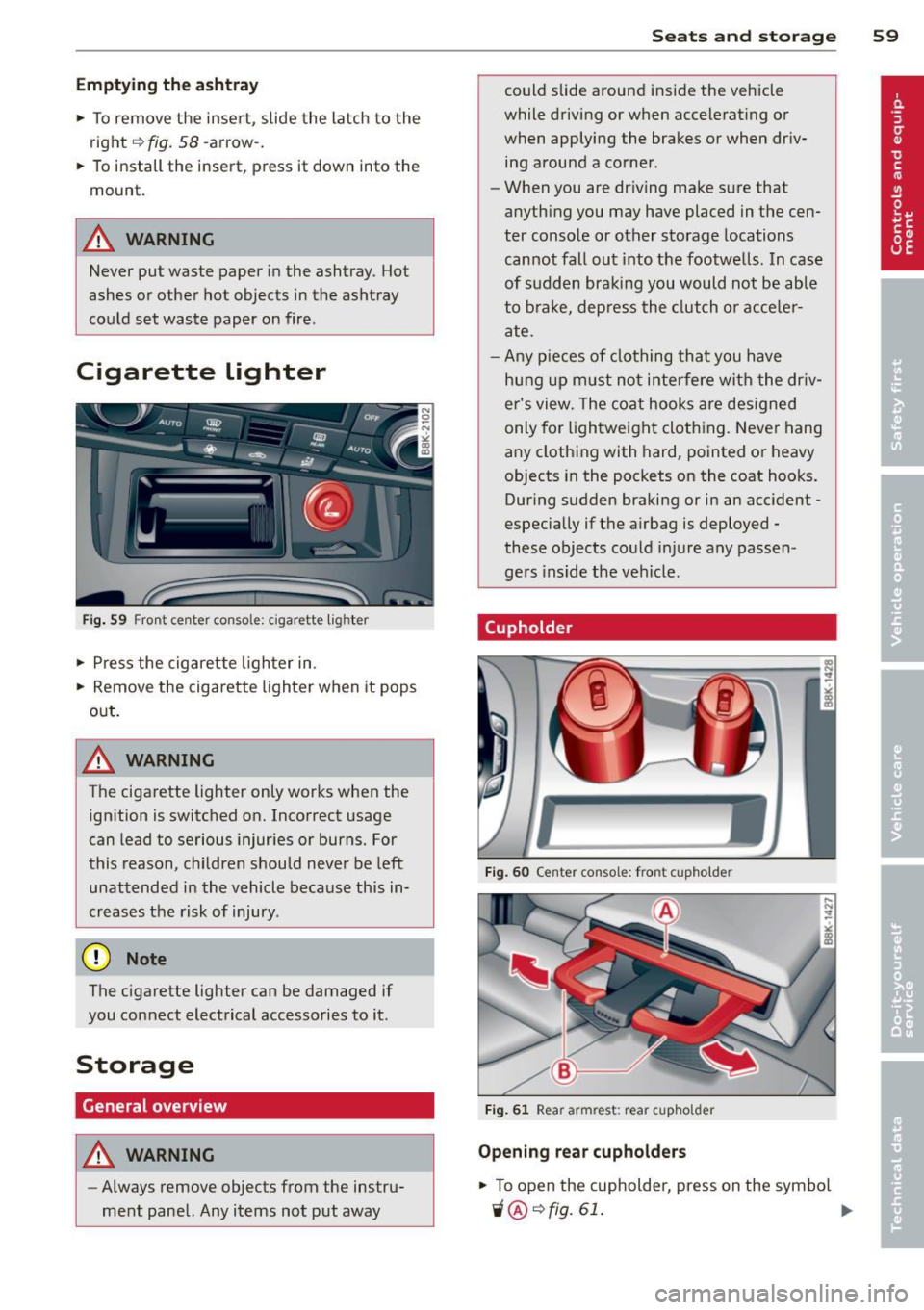
Emptying the ashtray
• To remove the insert , slide the latch to the
right
r:!) fig. 58 -arrow-.
• To install the insert , press it down into the
mount.
A WARNING
Never put waste paper in the ashtray . Hot
ashes or other hot objects in the ashtray
could set waste paper on fire.
Cigarette Lighter
Fig . 59 Fron t cen te r con so le: cigarette ligh ter
• Press the cigarette lighter in.
• Remove the cigarette lighter when it pops
out.
A WARNING
The cigarette lighter only works when the ign ition is switched on. Incorrect usage
can lead to serious injuries or burns. For
this reason, children should never be left
unattended in the vehicle because this in
creases the risk of injury .
(D Note
The cigarette lighter can be damaged if
you connect electrical accessories to it .
Storage
General overview
A WARNING
-Always remove objects from the instru
ment panel. Any items not put away
Seats and storage 59
could slide around inside the vehicle
while driving or when accelerat ing or
when applying the brakes or when driv
ing around a corner .
- When you are dr iving make sure that
anyth ing you may have placed in the cen
ter conso le or other storage locations
cannot fall out into the footwells . In case
of sudden braking you would not be able
to brake, dep ress the clutch or acce le r
ate.
- Any pieces of clothing that you have
hung up must not interfere wit h the driv
er's view. The coat hooks are designed
only for lightweight clothing. Never hang
any clothing with hard, pointed or heavy
objects in the pockets on the coat hooks.
During sudden braking or in an accident -
especially if the a irbag is deployed -
these objects could injure any passen
ge rs in side the vehicle.
Cupholder
Fig. 60 Cen ter c on sol e: fr ont cupholde r
Fig. 61 Rea r armrest: rear cupho ld er
Opening rear cupholders
• To open the cupholder, press on the symbo l
'i@ ¢ fig. 61 . ....
Page 63 of 294

cannot fall out into the footwells. In case
of sudden braking you would not be able
to brake or accelerate.
- Any articles of clothing that you have
hung up must not interfere with the driv
er's v iew. The coat hooks are designed
only for lightweight clothing. Never hang any clothing w ith hard, pointed or heavy
objects in the pockets on the coat hooks.
During sudden braking or in an accident -
especially if the airbag is deployed -
these objects cou ld injure any passen
gers inside the vehicle .
- To reduce the r isk of personal injury in an
accident or sudden stop, always keep the
glove compartment closed while driving.
- Read and fo llow all WARN INGS
~ page 161, Important safety instruc
tions on the side airbag system.
- Hang clothes in such a way that they do
not impair the driver's vision .
- T he coat hooks must only be used for
lightweight clothing. Do not leave any
heavy or sharp edged objects in the pock
ets which may interfere with the side cur
tain airbag deployment and can cause personal injury in a crash.
- Do not use coat hangers for hanging clothing on the coat hooks as this can in
terfere with proper deployment of the
side curtain airbags in an accident.
- Do not hang heavy objects on the coat
hooks, as they could cause personal in
jury in a sudde n stop.
- Always keep the compartment above the
rearview mirror closed while driving to
reduce the risk of injury in the event of
sudden braking maneuvers or a col lision.
(D Note
Objects located on the rear shelf that rub
aga inst the rear w indow cou ld damage the
heating wires for t he rear w indow defog
ger.
S ea ts a nd s to rage 61
@ Tips
-A vent slot is located between the shelf
and the rear w indow . Do not block the
vent with any items you may place on the
rear window she lf.
- Do not place bu lky items on the rear win
dow shelf as they could restrict or block
the driver's vision in the rear view m irror.
Roof rack
Description and mounting location s
Additional cargo can be carried with a roof
luggage rack.
F ig . 63 Roof rack attachmen t po ints
.,. Always read and follow the i nstructions pro
vided by the roof rack manufacturer when
installing the roof rack system.
If luggage or cargo is to be carried on the
roof, you must observe the fo llowing:
- Yo ur vehicle has aerodynam ic rai n gutters
mo lded into the roof. This is why conven
tional roof luggage racks cannot be used.
We recommend using roof racks from the
Audi orig inal accessories program.
- On ly use roof racks approved for your vehi
cle. These approved roof racks are the bas is
for a complete roof rack system. Addit ional
attachments or carrier systems are needed
to transport luggage and sports equipment.
We recommend using roof racks from the
Audi orig inal accessories program .
- When installing the roof rack, make sure it
is only mounted on the designated locations
on the roof
Q fig . 63 . ..,.
Page 64 of 294
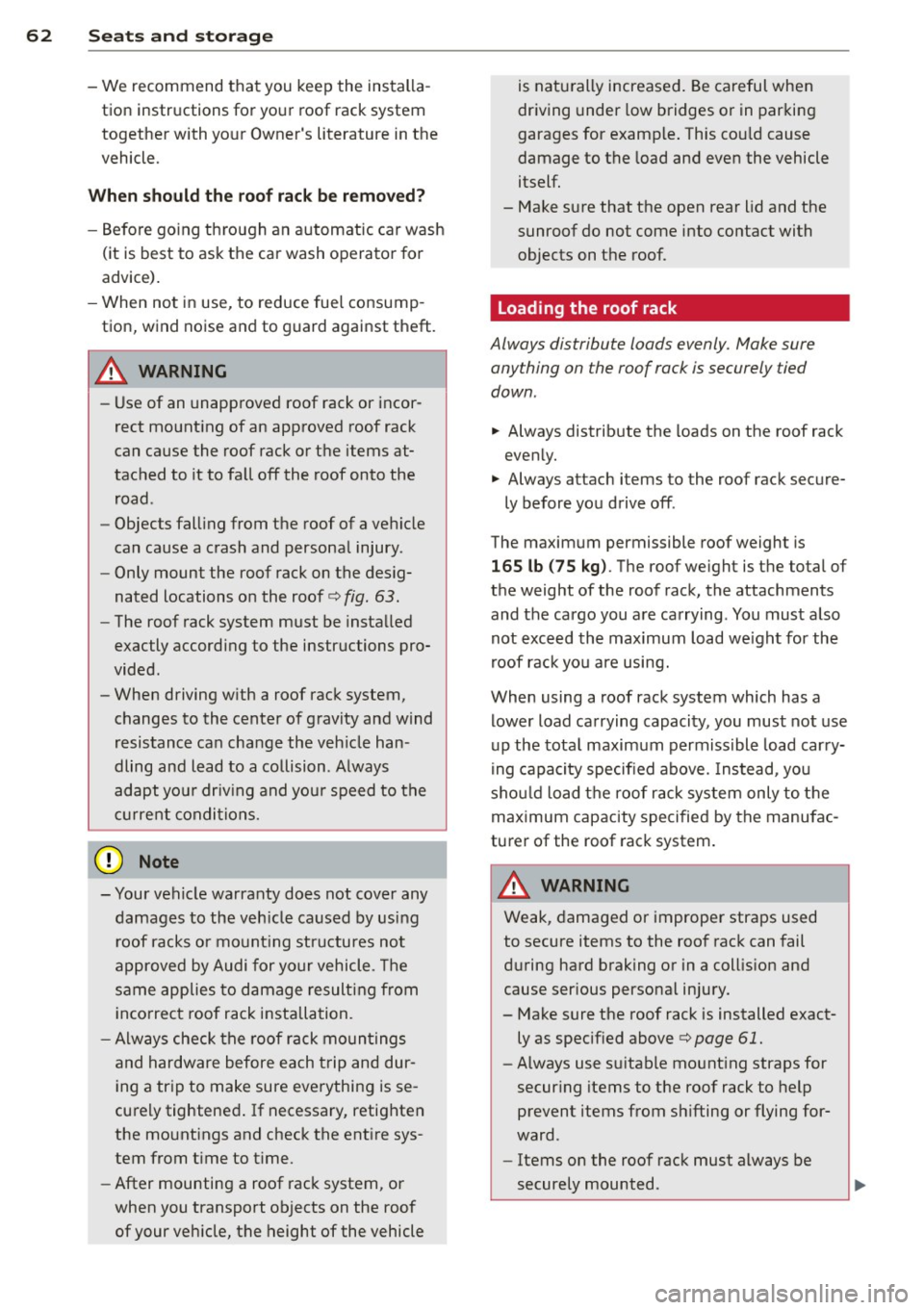
62 Seat s a nd s tor ag e
- We recommend that you keep the installa
tion instructions for your roof rack system
together with your Owner's literature in the
vehicle.
Wh en shoul d th e roof rack b e re mo ved?
-Before going th rough an automatic car wash
(it is best to ask the car wash operator for
advice).
- When not in use, to reduce fuel consump
tion, wind no ise and to guard against theft.
A WARNING
- Use of an unapproved roof rack or incor
rect mount ing of an approved roof rack
can cause the roof rack or the items at
tached to it to fall off the roof onto the road .
- Objects fall ing from the roof of a vehicle
can cause a crash and personal injury .
- Only mount the roof rack on the desig
nated locations on the roof¢ fig. 63.
- The roof rack system must be insta lled
exactly according to the instructions pro
vided.
- When driving w ith a roof rack system,
changes to the center of gravity and wind
resistance can change the veh icle han
dling and lead to a collision . Always
adapt you r driv ing and you r speed to the
cu rrent conditions.
@ Note
- Your vehicle warranty does not cover any
damages to the veh icle caused by using
roof racks or mo unt ing structures not
approved by Audi for yo ur vehicle . T he
same applies to damage resulting from
i ncorrect roof rack installation.
- Always check the roof rack moun tings
and hardware before each trip and dur ing a trip to make sure everything is se
curely tightened . If necessary, retighten
the mount ings and check the ent ire sys
tem from t ime to t ime.
- After mounting a roof rac k system, or
when you transport objects on the roof
of your veh icle, the height of the vehicle is naturally increased
. Be careful when
driving under low bridges or in parking
garages for example . This cou ld cause
damage to the load and even the vehicle
itself.
- Make sure that the open rear lid and the sunroof do not come into contact with
objects on the roof.
Loading the roof rack
Always distribute loads evenly. Make sure anything on the roof rack is securely tied
down.
.. Always distribute the loads on the roof rack
even ly.
.,. Always attach items to the roof rack secure-
ly before you drive off .
The maxim um permissible roof weight is
165 lb (75 kg ). The roof we ight is the total of
the weight of the roof rack, the attachments and the ca rgo you a re carrying. You must also
not exceed the max imum load we ight for the
r oof rack yo u are using.
When using a roof rack system which has a lower load carrying capacity, you must not use
up the tota l maximum permiss ible load carry
ing capac ity specif ied above. Ins tead, you
sho uld load the roof rack system only to the
maximum capacity specified by the manufac
turer of the roof rack system.
A WARNING
Weak, damaged or improper straps used
to secure items to the roof rack can fail
during hard braking or in a coll is ion and
cause ser ious persona l injury.
- Make sure the roof rack is installed exact ly as specified above¢ page 61.
- Always use s uitable mount ing straps for
secur ing items to the roof rack to help
prevent items from s hifting or flying for
ward .
- Items on the roof rack must always be
securely mounted.
Page 65 of 294
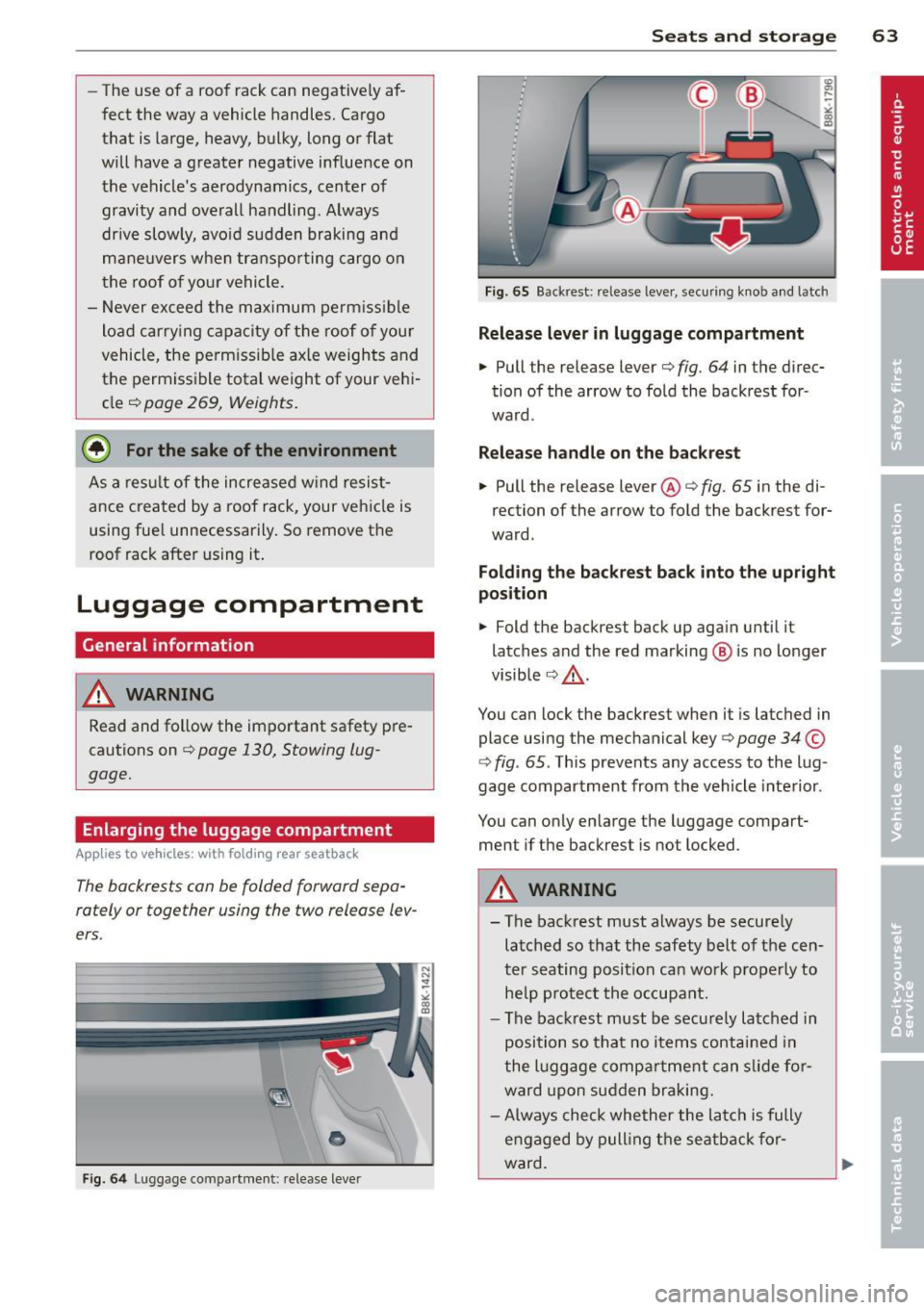
-The use of a roof rack can negative ly af
fect the way a vehicle handles. Cargo
that is large, heavy, bulky, long or flat
will have a greater negative influence on
the vehicle's aerodynamics, center of
gravity and overall handling . Always
dr ive slowly, avo id sudden braking and
maneuvers when transporting cargo on
the roof of your vehicle.
- Never exceed the max imum permissible
load carry ing capacity of the roof of your
vehicle, the perm issib le axle weights and
the permissible total weight of your vehi
cle
c::> page 269, Weights.
@) For the sake of the environment
As a result of the increased w ind resist
ance created by a roof rack, your vehicle is
using fue l unnecessarily . So remove the
roof rack after using it .
Luggage compartment
General information
A WARNING
Read and follow the important safety pre
cautions on c:>
page 130, Stowing lug
gage.
Enlarging the luggage compartment
App lies to vehicles: with fold ing rear seatback
The backrests can be folded forward sepa
rately or together using the two release lev
ers .
0
Fig. 64 Luggage compartment: re lease leve r
Seats and storage 63
Fig. 65 Backrest: release lever, securing knob and latc h
Release lever in luggage compartment
... Pull the release lever c:> fig. 64 in the direc
tion of the arrow to fo ld the backrest for
ward .
Release handle on the backrest
... Pull the release lever@c:> fig. 65 in the di
rection of the arrow to fold the backrest for
ward .
Folding the backrest b ack into the upright
position
... Fold the backrest back up again until it
latches and the red marking @ is no longer
visible
c:> .&_ .
You can lock the backrest when it is latched in
place using the mechanical key
c:> page 34 ©
c:> fig . 65 . This prevents any access to the lug
gage compartment from the vehicle interior.
You can only enlarge the luggage compart ment if the backrest is not locked.
A WARNING
-
- The backrest must always be securely
latched so that the safety belt of the cen
ter seating position can work properly to
he lp protect the occupant.
- The backrest must be securely latched in
position so that no items contained in
the lu ggage compa rtment can slide for
ward upon sudden braking.
- Always check whether the latch is fully
e ngag ed by pull ing the seatback for
ward .
Page 66 of 294

64 Seats and storage
-Never allow safety belts to become dam
aged by being caught in door or seat
hardware.
- Torn or frayed safety belts can tear and
damaged belt hardware can break in a
crash. Inspect the belts periodically.
Belts showing damage to webbing, bind
ings, buckles, or retractors must be re
placed.
(D Note
- If you move the front seat back when the
rear seat backrest is folded forward, you
could damage the head restraints on the
rear seat.
- Slide the belt guide on the outside safety
belt all the way up before folding the
backrest back forward. Make sure the
seat belt is not pinched or damaged
when the rear seat backrest if folded
back. Other objects should be removed
from the rear seat bench to protect the
seatback from damage.
Tie-downs and cargo net
Applies to vehicles: with cargo net
The cargo net prevents small objects from
sliding.
Fig. 66 Luggage compartment: cargo net stretched
ou t
Fig. 67 Luggage compart ment : cargo net at the top of
t he lu ggage compar tmen t
Net stretched out
.. To secure objects with the cargo net, hang
the front hooks on the net in the tie-downs
first and then hang the rear hooks~
fig. 66.
Net at the top of the luggage
compartment
.. Hang the hooks on the cargo net in the tie
downs on the floor at the rear of the lug
gage compartment ~
fig. 67.
.. Fold down the hooks at the upper area of
the luggage compartment down, pull the
net up and hang the eyelets on the net on
the hooks .
In a collision, the laws of physics mean that
even smaller items that are loose in the vehi
cle will turn into heavy missiles that can cause
serious injury. Items in the vehicle pick up ki
netic energy which varies with the vehicle and
the weight of the item. Vehicle speed is the
most significant factor.
For example, in a frontal collision at a speed
of 30 mph (48 km/h), the forces acting on a
10-lb (S kg) object are about
20 times the
normal weight of the item. This means that
the weight of the item would suddenly be the
equivalent of about 200 lbs (90 kg). One can
easily imagine the injuries that an item of that
weight flying freely through the passenger compartment can cause in a collision at a
speed considered relatively low.
Page 72 of 294
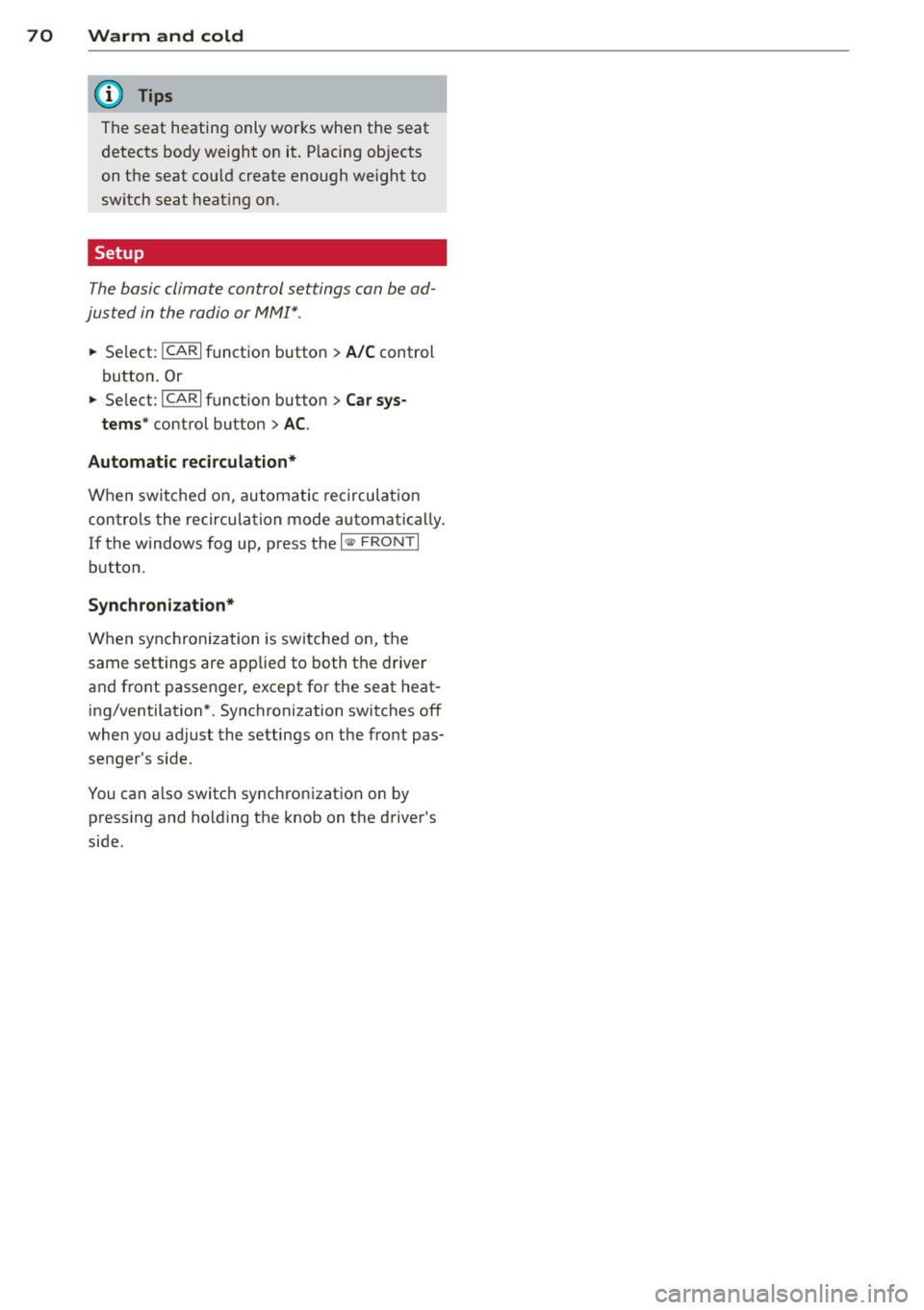
70 Warm and cold
The seat heating only works when the seat
detects body weight on it. P lacing objects
on the seat cou ld create enough we ight to
sw itch seat heat ing on.
Setup
The basic climate control settings can be ad
justed in the radio or MM!* .
.. Se lect:
ICARI function button> A /C control
button . Or
.. Se lect:
I CARI funct ion button> Car sys -
tems "
control button > AC.
Automatic recirculation*
When switched on, automatic recirculation
controls the recirculation mode automatica lly.
If the windows fog up, press the
1 ~ FRONT I
button.
Synchronization*
When synch roniza tion is switched on, the
same settings are applied to both the drive r
and front passenger, except for the seat heat ing/ventilation*. Synchronization switches off
when you ad just the settings on the front pas
senger's side.
You can a lso switch synchronization on by
press ing and ho lding the knob on the driver's
side.
Page 80 of 294
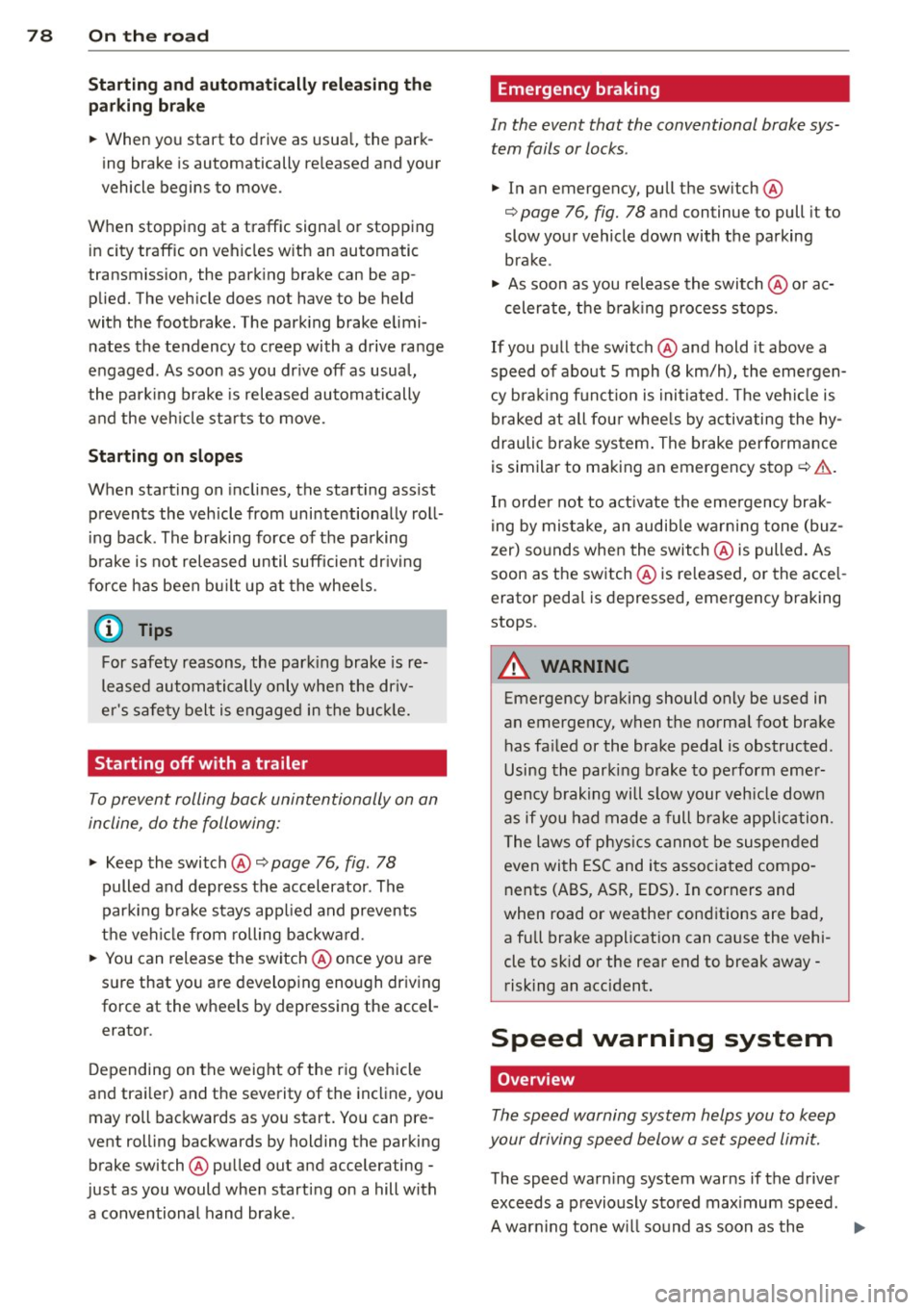
78 On the road
Startin g and automati cally r ele a s ing the
p ark ing b rake
.. When you start to drive as usua l, the park
ing brake is automatically released and your
vehicle begins to move.
When stopping at a traffic signal or stopping
in city traffic on vehicles with an automatic
transmission, the parking brake can be ap
plied. The vehicle does not have to be held
with the footbrake. The park ing brake elimi
nates the tendency to creep with a drive range
engaged. As soon as you dr ive off as usual,
the park ing brake is released automatically
and the veh icle starts to move .
Starting on slopes
When starting on inclines, the start ing ass ist
prevents the vehicle from unintentionally roll
ing back. The braking force of the parking
b rake is not released until sufficient dr iving
fo rce has been bu ilt up at the whee ls.
(D Tips
For safety reasons, the park ing brake is re
leased automatically only when the dr iv
er 's sa fety belt is engaged in the bu ck le.
Starting off with a trailer
To prevent rolling back unintentionally on an
incline, do the following:
.. Keep the switch@c::> page 76, fig. 78
pulled and depress the accelerator . The
parking b rake stays applied and prevents
the vehi cle from rolling backward.
.. You can release the switch @once you are
s u re that yo u are developing enough driving
force at the wheels by depressing the accel
erator.
Depending on the weight o f the rig (vehicle
and trai ler) and the severity of the incline, you
may roll backwards as you start . Yo u can pre
vent roll ing backwards by holding the parking
brake switch @pulled out and accelerating -
just as you would when starting on a hill with
a conventional hand brake.
Emergency braking
In the event that the conventional brake sys
tem fails or locks .
.. In an emergency, pull the switch@
c::> page 76, fig. 78 and continue to pull it to
slow your vehicle down with the parking brake .
.. As soon as you release the switch @or ac-
celerate, t he b ra ki ng pro cess stops.
If you pull the switch @and hold it above a
speed of about 5 mph (8 km/h), the emergen
cy bra king funct ion is initiated. The ve hicl e is
braked at all fou r whee ls by activating the hy
draulic brake sys tem. The brake performance
is similar to making an emergency stop
c::> ,&.
In order not to a ct ivate the eme rgency brak
ing by mis take, an audib le warning tone (buz
zer) so unds when the switch @is pulled. As
soon as the switch @ is released, or the acce l
erator pedal is depressed, emergency braking
stops.
A WARNING ,-
Emergency braking should only be used in
an emergency, when the normal foot brake
has fa iled or the brake pedal is obstructed .
Using the par king brake to pe rform eme r
gency b raking will s low your veh icle down
as if you had made a full brake application.
The laws of phys ics cannot be suspended
even with ESC and its associated compo
nents (ABS, ASR, EDS). In corners and
when road or weathe r cond itions are bad,
a full brake application can cause the vehi
cle to skid or the rear end to break away
risking an accident.
Speed warning system
Overview
The speed warning system helps you to keep
your driving speed below a set speed limit.
T he speed warn ing system warns if the driver
exceeds a p reviously sto red max imum speed.
A warning tone w ill sound as soon as the
Ill-
Page 132 of 294

130 Driving Safel y
the pedals or the ability to control the
vehicle.
- Never place or insta ll floor mats or other
floor coverings on top of already insta l
led floor mats. Additional floor mats and
other coverings will reduce the size of
the pedal area and interfere with the
peda ls.
- Always proper ly reinstall and secure floor
mats that have been taken out fo r clean
ing.
- Always make sure that objects cannot
fall into the driver footwell while the vehicle is moving. Objects can become
trapped unde r the b rake pedal and accel
erator peda l causing a loss of veh icle
contro l.
Stowing luggage
Loading the luggage compartment
All luggage and other objects must be prop
erly stowed and secured in the luggage com
partment.
Fig. 12 9 Safe load pos it io nin g: place heavy objects as
low a nd as fa r forward as possible .
Loose items in the luggage compartment can
shift suddenly, changing vehicle hand ling
characteristics . Loose items can also increase
the risk o f serious personal injury in a sudden
vehicle maneuver or in a collision .
.,. Distribute the load evenly in the luggage
compartment .
.,. Always place and properly secure heavy
items in the luggage compartment as low
and as far forward as poss ible
Q fig . 129 .
.,. Secure the load with the cargo net* or with
non-elastic straps secured to the tie-downs
¢ page 64.
.,. Make sure that the rear seatback is securely
latched in place.
A WARNING
Improperly stored luggage or other items
ca n fly through the vehicle causing ser ious
personal injury in the event of hard brak
i ng or an accident. To help reduce t he risk
of ser ious personal inj ury:
- Always put objects, for example, luggage or other heavy items in the luggage com
pa rtment.
- Always secure objects in the luggage
compa rtment using the t ie-down eyelets
and suitab le straps .
A WARNING
-
Heavy loads wi ll influence the way yo ur ve-
hicle handles. To help reduce the risk of a
l oss of contro l leading to serious personal
i njury:
- Always keep in mind when transporting
heavy objects, that a change in the cen
ter of gravity can also cause changes in
veh icle handling:
- Always distribute the load as evenly as poss ible.
- Place heavy objects as far forward in
the luggage compartment as possible.
- Never exceed the Gross Axle We ight Rat
ing or the Gross Vehicle We igh t Rating
specified on the safe ty compl iance stick
er on the left door jamb . Exceeding per
missible weight standards can cause the
vehicle to slide and hand le differently .
- Please observe information on safe driv ing¢
page 124.
A WARNING
-To he lp prevent poisonous exhaust gas
from being drawn into the vehicle, a lways
keep the rear lid closed w hile driving.
Page 133 of 294

-Never transport objects larger than
those fitting completely into the luggage
area because the rear lid cannot be fully
closed.
- If you absolutely must drive with the rear
lid open, observe the following notes to
reduce the risk of poisoning:
- Close all windows,
- Close the sunroof,
- Open all air outlets in the instrument
panel,
- Switch off the air recirculation,
- Set the fresh air fan to the highest
speed .
A WARNING
Always make sure that the doors, all win
dows, the sunroof and the rear lid are se
curely closed and locked to reduce the risk
of injury when the vehicle is not being
used.
- After closing the rear lid, always make
sure that it is properly closed and locked.
- Never leave your vehicle unattended es
pecially with the rear lid left open. A
child could crawl into the vehicle through
the luggage compartment and close the
rear lid becoming trapped and unable to
get out. Being trapped in a vehicle can
lead to serious personal injury.
- Never let children play in or around the
vehicle.
- Never let passengers ride in the luggage
compartment . Vehicle occupants must
always be properly restrained in one of
the vehicle's seating positions.
@ Tips
- Air circulation helps to reduce window fogging. Stale air escapes to the outside
through vents in the trim panel. Be sure
to keep these slots free and open.
- The tire pressure must correspond to the
load. The tire pressure is shown on the
tire pressure label. The tire pressure la bel is located on the driver's side B-pillar.
The tire pressure label lists the recom-
-
Driving Safely 131
mended cold tire inflation pressures for
the vehicle at its maximum capacity
weight and the tires that were on your
vehicle at the time it was manufactured.
For recommended tire pressures for nor
mal load conditions, please see chapter
r::> page235 .
Tie-downs
The luggage compartmen t is equipped with
four tie -downs to secure luggage and other
items .
Use the tie-downs to secure your cargo prop
erly
r::> page 130, Loading the luggage com
partment .
In a collision, the laws of physics mean that
even smaller items that are loose in the vehi
cle will become heavy missiles that can cause
serious injury. Items in the vehicle possess en
ergy which vary with vehicle speed and the
weight of the item. Vehicle speed is the most
significant factor.
For example, in a frontal collision at a speed
of 30 mph (48 km/h), the forces acting on a
10-lb (4.5 kg) object are about 20 times the
normal weight of the item . This means that
the weight of the item would suddenly be about 200 lbs . (90 kg). You can imagine the
injuries that a 200 lbs. (90 kg) item flying
freely through the passenger compartment
could cause in a collision like this.
A WARNING
Weak, damaged or improper straps used
to secure items to tie-downs can fail dur
ing hard braking or in a collision and cause
serious personal injury.
-Always use suitable mounting straps and
properly secure items to the tie-downs in
the luggage compartment to help pre
vent items from shifting or flying for
ward as dangerous missiles.
- When the rear seat backrest is folded
down , always use suitable mounting
straps and properly secure items to the
tie-downs in the luggage compartment
•
•
Page 137 of 294

Why safety belts?
Frontal collisions and the law of physics
Frontal crashes create very strong forces for
people riding in vehicles .
Fig. 131 U nbe lted occupa nts in a ve hicle hea ding for a
wall
F ig. 1 32 The ve hicle c ras hes into t he wall
The physical principles are simp le. Both the
ve hicle and the passengers possess energy
which varies w ith vehicle speed and body
weight . Enginee rs call this energy "kinetic en
e rgy ."
The higher the speed of the vehicle and the greater the vehicle 's weight, the more energy
that has to be "absorbed" i n the crash .
Vehicle speed is the most sign ificant factor . If
the speed doubles from 15 to 30 mph (25 to
50 km/h) , the energy inc reases 4 t imes !
Because t he passengers of t his ve hicle are not
using safety belts
r::;, fig . 131, they w ill keep
moving at the same speed the vehicle was
mov ing just before the crash, unt il something
stops them -here, the wall
c:> fig . 132 .
The same pr inc iples apply to peop le sitting in
a vehicle that is involved in a frontal co llision .
Even at city speeds of 20 to 30 mph (30 to
50 km/h) , the forces act ing on the body can Safety belts
135
reach one ton (2,000 lbs . or 1,000 kg) or
more . At greater speeds, these forces are
even
higher .
People who do not use sa fe ty belts are also
not attached to their vehicle. In a frontal coll i
sio n they wi ll also keep moving forward at the
speed their veh icle was t ravell ing just before
the crash. Of co urse, the laws of physics don't
just app ly to frontal collisions, they determine
what happens in all kinds of acc idents and col
lis ions .
What happens to occupants not wearing
safety belts?
In crashes unbelt ed o ccupants cannot stop
themselves from flying forward and being in
jured or killed. Always wear your safety belts!
Fig. 133 A driver not wear ing a safety belt is vi ole ntl y
thrown forwa rd
Fig. 1 34 A rear passeng er not w ear ing a safety be lt
w ill fly forwar d and s trike the d river
Unbelted occ upants a re not able to resist the
tremendous forces of impact by holdi ng tight
or bracing themselves . Without the benefit of
safe ty restra in t systems, the unrestrained oc
cupan t w ill slam violen tly i nto the s teer ing
whee l, instr ument pane l, w indshield, o r what
ever else is in the way ¢ fig. 133. This impact Ill-